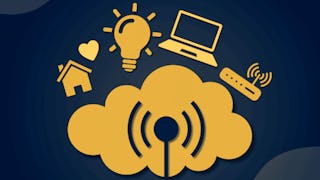This course builds on the previous course: IoT Devices. After we have built and programmed a small self-driving vehicle, now it's time get into more advanced territory and enhance the device's connectivity further. To do so you will study radio frequency (RF) communication, the MAC layer, Mesh Networking as well as distributed algorithms for use with geographic locations. These techniques will be applied to your device in the lab, which is composed of four steps, one in each week of the course. In Week 1, after going over some orientation for the course, you will focus on radio frequency (RF) communication, how it fits in with the larger scope of electromagnetism, how RF signals propagate in physical environments, how RF signals can be used to encode data, and how all this information is useful in constructing resilient and high-bandwidth IoT communication substrates.

Enjoy unlimited growth with a year of Coursera Plus for $199 (regularly $399). Save now.

IoT Communications
This course is part of Hands-on Internet of Things Specialization

Instructor: Matthew Caesar
10,448 already enrolled
Included with
(69 reviews)
Recommended experience
Skills you'll gain
Details to know

Add to your LinkedIn profile
8 assignments
See how employees at top companies are mastering in-demand skills

Build your subject-matter expertise
- Learn new concepts from industry experts
- Gain a foundational understanding of a subject or tool
- Develop job-relevant skills with hands-on projects
- Earn a shareable career certificate

There are 4 modules in this course
Welcome to IoT Communications. This course builds on the previous course: IoT Devices. After we have built and programmed a small self-driving vehicle, now it's time get into more advanced territory and enhance the device's connectivity further. To do so you will study radio frequency (RF) communication, the MAC layer, Mesh Networking as well as distributed algorithms for use with geographic locations. As part of the "Honors" activity, these techniques will be applied to your device in the lab, which is composed of four steps, one in each week of the course. In Week 1, after going over some orientation for the course, you will focus on radio frequency (RF) communication, how it fits in with the larger scope of electromagnetism, how RF signals propagate in physical environments, how RF signals can be used to encode data, and how all this information is useful in constructing resilient and high-bandwidth IoT communication substrates.
What's included
7 videos7 readings2 assignments1 discussion prompt
We will learn about the lowest level of communication protocols in IoT - the MAC layer. This is the layer that deals with all the unpleasant and challenging situations that come about through the use of RF in challenging environments. We will learn about mechanisms to efficiently send and receive data, with low power, discover and pair with other nodes, deal with transmission collisions, and so on.
What's included
8 videos2 readings2 assignments1 discussion prompt
We will talk about mesh networking, a set of techniques that allow wireless devices to work together to discover and maintain working paths to destinations. These techniques enable communication across multiple hops, by having nodes help each other out, routing through multiple layers of intermediate proxies to construct paths to any destination that needs to be reached. The techniques we talk about in this lecture form the foundation for many operations needed to be conducted in IoT, such as dissemination, replication, multicast, service discovery, and so on.
What's included
12 videos2 readings2 assignments1 discussion prompt
We will study the next layer up of distributed algorithms that are used in IoT networks. We will continue our exploration of mesh routing, and describe how such techniques can be used to place data at geographic locations, forward in "intermittently-connected" setting, perform multicast, and more.
What's included
4 videos2 readings2 assignments1 discussion prompt
Earn a career certificate
Add this credential to your LinkedIn profile, resume, or CV. Share it on social media and in your performance review.
Prepare for a degree
Taking this course by University of Illinois Urbana-Champaign may provide you with a preview of the topics, materials and instructors in a related degree program which can help you decide if the topic or university is right for you.
Instructor

Offered by
Explore more from Mobile and Web Development
 Status: Preview
Status: PreviewInstitut Mines-Télécom
 Status: Free Trial
Status: Free TrialUniversity of Illinois Urbana-Champaign
 Status: Free Trial
Status: Free TrialUniversity of Illinois Urbana-Champaign
 Status: Preview
Status: PreviewIIT Bombay
Why people choose Coursera for their career




Learner reviews
69 reviews
- 5 stars
72.46%
- 4 stars
24.63%
- 3 stars
1.44%
- 2 stars
0%
- 1 star
1.44%
Showing 3 of 69
Reviewed on Feb 4, 2023
A very detailed course covering a wide range of topics on IOT communications.
Reviewed on Mar 30, 2022
i never see like this coursecourse is very and understandable

Open new doors with Coursera Plus
Unlimited access to 10,000+ world-class courses, hands-on projects, and job-ready certificate programs - all included in your subscription
Advance your career with an online degree
Earn a degree from world-class universities - 100% online
Join over 3,400 global companies that choose Coursera for Business
Upskill your employees to excel in the digital economy
Frequently asked questions
To access the course materials, assignments and to earn a Certificate, you will need to purchase the Certificate experience when you enroll in a course. You can try a Free Trial instead, or apply for Financial Aid. The course may offer 'Full Course, No Certificate' instead. This option lets you see all course materials, submit required assessments, and get a final grade. This also means that you will not be able to purchase a Certificate experience.
When you enroll in the course, you get access to all of the courses in the Specialization, and you earn a certificate when you complete the work. Your electronic Certificate will be added to your Accomplishments page - from there, you can print your Certificate or add it to your LinkedIn profile.
Yes. In select learning programs, you can apply for financial aid or a scholarship if you can’t afford the enrollment fee. If fin aid or scholarship is available for your learning program selection, you’ll find a link to apply on the description page.
More questions
Financial aid available,

